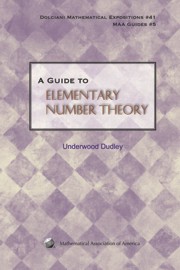Book contents
- Frontmatter
- Introduction
- Contents
- 1 Greatest Common Divisors
- 2 Unique Factorization
- 3 Linear Diophantine Equations
- 4 Congruences
- 5 Linear Congruences
- 6 The Chinese Remainder Theorem
- 7 Fermat's Theorem
- 8 Wilson's Theorem
- 9 The Number of Divisors of an Integer
- 10 The Sum of the Divisors of an Integer
- 11 Amicable Numbers
- 12 Perfect Numbers
- 13 Euler's Theorem and Function
- 14 Primitive Roots and Orders
- 15 Decimals
- 16 Quadratic Congruences
- 17 Gauss's Lemma
- 18 The Quadratic Reciprocity Theorem
- 19 The Jacobi Symbol
- 20 Pythagorean Triangles
- 21 x4 + y4 ≠ z4
- 22 Sums of Two Squares
- 23 Sums of Three Squares
- 24 Sums of Four Squares
- 25 Waring's Problem
- 26 Pell's Equation
- 27 Continued Fractions
- 28 Multigrades
- 29 Carmichael Numbers
- 30 Sophie Germain Primes
- 31 The Group of Multiplicative Functions
- 32 Bounds for π(x)
- 33 The Sum of the Reciprocals of the Primes
- 34 The Riemann Hypothesis
- 35 The Prime Number Theorem
- 36 The abc Conjecture
- 37 Factorization and Testing for Primes
- 38 Algebraic and Transcendental Numbers
- 39 Unsolved Problems
- Index
- About the Author
17 - Gauss's Lemma
- Frontmatter
- Introduction
- Contents
- 1 Greatest Common Divisors
- 2 Unique Factorization
- 3 Linear Diophantine Equations
- 4 Congruences
- 5 Linear Congruences
- 6 The Chinese Remainder Theorem
- 7 Fermat's Theorem
- 8 Wilson's Theorem
- 9 The Number of Divisors of an Integer
- 10 The Sum of the Divisors of an Integer
- 11 Amicable Numbers
- 12 Perfect Numbers
- 13 Euler's Theorem and Function
- 14 Primitive Roots and Orders
- 15 Decimals
- 16 Quadratic Congruences
- 17 Gauss's Lemma
- 18 The Quadratic Reciprocity Theorem
- 19 The Jacobi Symbol
- 20 Pythagorean Triangles
- 21 x4 + y4 ≠ z4
- 22 Sums of Two Squares
- 23 Sums of Three Squares
- 24 Sums of Four Squares
- 25 Waring's Problem
- 26 Pell's Equation
- 27 Continued Fractions
- 28 Multigrades
- 29 Carmichael Numbers
- 30 Sophie Germain Primes
- 31 The Group of Multiplicative Functions
- 32 Bounds for π(x)
- 33 The Sum of the Reciprocals of the Primes
- 34 The Riemann Hypothesis
- 35 The Prime Number Theorem
- 36 The abc Conjecture
- 37 Factorization and Testing for Primes
- 38 Algebraic and Transcendental Numbers
- 39 Unsolved Problems
- Index
- About the Author
Summary
Gauss's Lemma is needed to prove the Quadratic Reciprocity Theorem, that for odd primes p and q, (p/q) = (q/p) unless p ≡ q ≡ 3 (mod 4), in which case (p/q) = -(q/p), but it also has other uses.
Theorem (Gauss's Lemma) Suppose that p is an odd prime, p ∤ a, and that among the least residues (mod p) of a, 2a, …, ((p-1)/2)a exactly g are greater than (p - 1)/2. Then (a/p) = (-1)g.
Proof Divide the least residues (mod p) of a, 2a, …, ((p - 1)/2)a into two classes: r1, r2, …, rk that are less than or equal to (p - 1)/2 and s1, s2, …, sg that are greater than (p - 1)/2. Then k + g = (p - 1)/2. By Euler's Criterion, to prove the theorem it is enough to show that a(p-1)/2 ≡ (-1)g (mod p).
No two of r1, r2, …, rk are congruent (mod p). If they were we would have k1a ≡ k2a (mod p) and, because (a, p) = 1, k1 ≡ k2 (mod p). Because k1 and k1 are both in the interval [1, (p -1)/2] we have k1 = k1.
Information
- Type
- Chapter
- Information
- A Guide to Elementary Number Theory , pp. 57 - 60Publisher: Mathematical Association of AmericaPrint publication year: 2009
